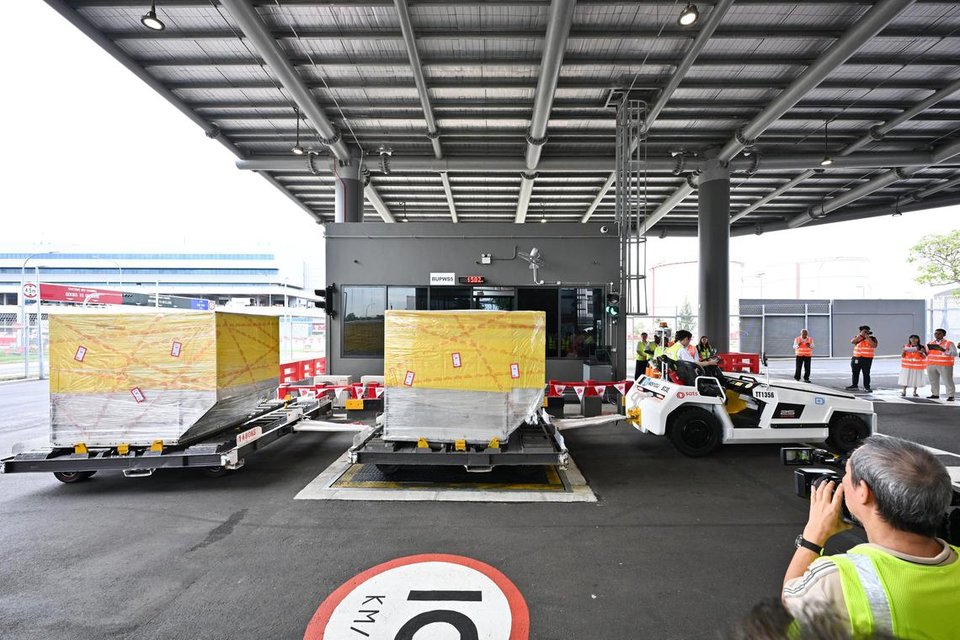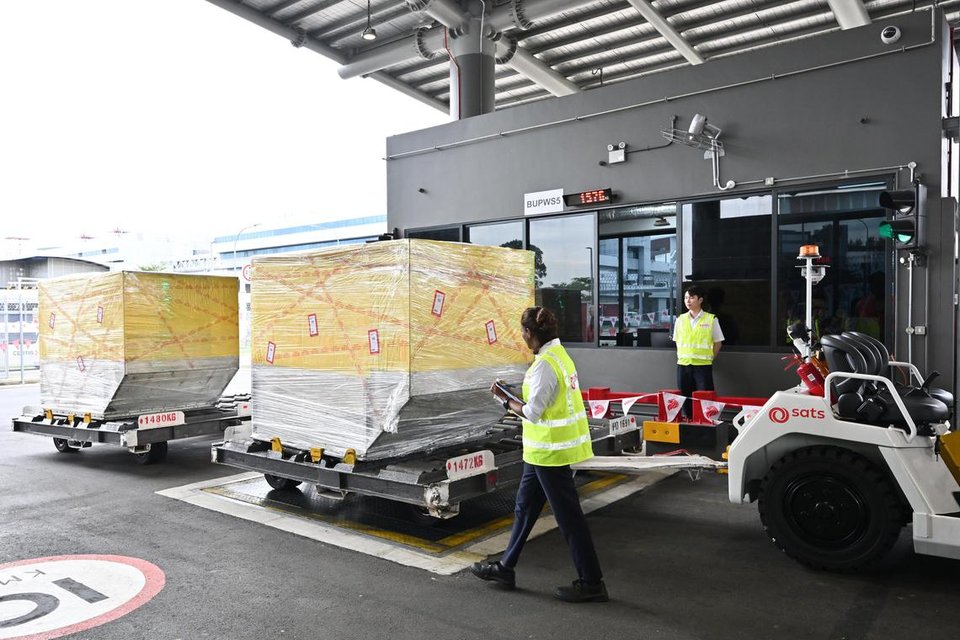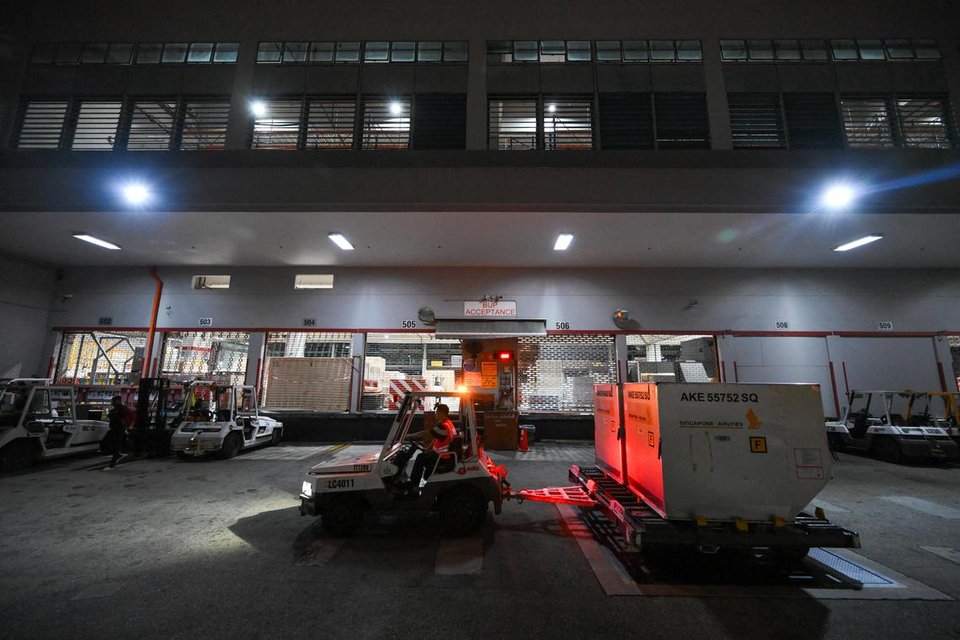New ‘drive-through’ cargo centre at Changi Airport cuts processing time; will be test bed for T5 ops

(Photo credit: ST Photo/Lim Yaohui)
Source: The Straits Times
A new air cargo handling centre in Singapore, said to be the first of its kind in the world, features a drive-through concept capable of reducing processing time for air cargo shipments by 20 per cent. It officially opened on Aug 5.
The 3,000 sq m Bulk Unitisation Programme (BUP) Handling Centre is able to process outgoing air cargo shipments in two hours, instead of 2½ hours.
BUP is a packing strategy that consolidates loose cargoes into standardised, ready-to-ship individual units such as pallets or containers to speed up handling processes. It is typically used for consumer and electronic goods such as clothes and household products.
Before the launch of the centre, freight forwarders needed to transport loose cargoes to a warehouse for packing into pallets or containers for loading onto an aircraft, in addition to some ready-to-ship individual units.
Built by ground-handling services provider Sats, the facility in Changi Airfreight Centre, next to Changi Airport Terminal 1, will also test-bed enhanced air cargo processes and systems for the upcoming Terminal 5 (T5) and the Changi East Industrial Zone. The industrial zone is an airport logistics park that will optimise the flow of air cargoes and reduce the costs and transit time for processing goods to and from T5.
As Sats has to work with the space available in the facilities here before the opening of the zone in the mid-2030s, it is important to maximise the use of the space it has by moving ready-to-ship units into a dedicated facility, said Mr Kuah Boon Kiam, senior vice-president for cargo services at Sats.
Faster processing time at the new centre comes from the acceleration of the acceptance process, in which freight forwarders hand the goods over to handlers to check the weight and shape of the cargoes to ensure they can fit into the aircraft, as well as to verify documents.
With the drive-through concept, this has been halved from 10 to 15 minutes to five to eight minutes.
The cargo handling processes at the previous air freight terminals were manual, as workers needed to use forklifts to place the cargoes onto weighing machines before transferring them into the warehouse for packing and acceptance.
Each terminal had only one weighing machine, which often led to congestion at the roads near the terminals.

(Photo credit: ST Photo/Lim Yaohui)
The new centre is equipped with six cargo lanes and six weighing stations, where freight forwarders can just drive their tractors and cargo dollies in to deposit their cargoes after getting them processed. Cargoes are weighed while they are still on the dollies.
The cargoes will then be towed to the airside.
The centre will be manned by a team of 20, and the workers will need to perform new tasks such as verifying documents and checking cargoes to ensure they are ready for loading, instead of executing tasks such as moving cargoes.
Sats declined to reveal the construction cost of the new centre.
Mr Kuah said freight forwarders can now go through a much more straightforward and simple acceptance process in a “more spacious” set-up.
It is similar to the clearance lanes for cargo trucks at the Tuas and Woodlands land checkpoints, Sats noted.
Mr Kuah gave these details during a media tour on the night of July 28, noting that the centre will streamline cargo flow and boost handling efficiency.
Sats had previously operated two air freight terminals – one for Singapore Airlines and the other for all other airlines it serves. They have been repurposed since April 7.
Hence, Mr Kuah described the new sheltered facility as a “one-stop shop” for cargo handling for all airlines. It started operations in early April.

(Photo credit: ST Photo/Shintaro Tay)
With the new centre, Sats hopes to increase the amount of freight it handles in BUP units from the current 30 to 35 per cent of its total volume to at least 50 per cent over the next one to 1½ years.
Mr Kuah noted that the new facility is able to handle 600 units daily, double Sats’ previous volume of 300 units in total for both terminals.

(Photo credit: ST Photo/Shintaro Tay)
Adding that the utilisation rate is now at 50 per cent, Mr Kuah said Sats had designed it this way with a lot of room to grow.
“This will be a test bed for what we intend to do for the new Changi East Industrial Zone, because that will be (launched) in the mid-2030s – so a lot of the things that we’re doing right now will basically lead up to that.”
“So we will obviously look at how we are doing it now – if it works very well, then we will replicate it for the new facility. If there are certain improvements that need to be done, then we’ll have time to do them before we move to the new facility in the mid-2030s,” he added.
Speaking to the media at the opening ceremony on Aug 5, Mr Kerry Mok, president and chief executive of Sats, said there is a need for Singapore’s air cargo sector to be resilient amid the ongoing tariffs.
He said Sats thus needs to improve its existing facilities and drive new cargo handling processes to support the rise in volume, because there will be no new infrastructure for the next 10 years until the Changi East Industrial Zone is ready.
Noting that the BUP centre will allow Sats to handle increased cargo volumes using the same infrastructure, Mr Mok said: “When T5 comes, these are some of the new ideas that can be launched in the design of T5. So we can’t wait, we’ve got to do it now.”
He added: “And to do it now, it means we can then design something better for T5.”
On the impact of the new facility on Singapore’s position as a transit hub, Mr Kuah said any kind of time savings that Sats can give to the air cargo logistics industry will give the Republic a competitive edge.
Global air cargo demand will grow by 4 per cent to 6 per cent year on year in 2025, according to freight data analysts. Likewise, South-east Asia’s e-commerce market is expected to grow at an average rate of 22 per cent annually from 2025 to 2026.
